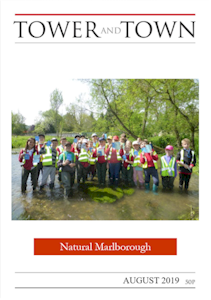

Tower and Town, August 2019 (view the full edition) (view the full edition)Dormouse: Wildlife SuperstarThe wooded landscapes surrounding Marlborough, characterised by the Savernake Forest and West Wood, support the dormouse, a superstar of woodlands by night. The dormouse (Muscardinus avellanarius) is a small rodent, with the large eyes of a nocturnal species, and the characteristic furry tail. The dormouse is sensitive to weather and climate (impacting their food and hibernation) and as the effects of climate change are felt, concern for dormouse populations increases. The dormouse is a protected species and a national and local priority for conservation. Dormice use a wide variety of habitats, from broad-leaved woodland, to conifer plantations, to hedgerows, scrub and coastal gorse. They should be considered a species of wooded landscapes, rather than just woodlands, using the hedgerow and scrub networks to move through the landscape. It's likely that dormice have been a feature of the area's woodlands for centuries, well known by local woodsmen who often found them when coppicing hazel and sweet chestnut. Dormice have been formally recorded in the Savernake Forest since at least 1975 and studied in detail since the 2000s. Today, members of Wiltshire Mammal Group, with the support of Forestry Commission and local Estates, undertake detailed monitoring of dormice at three locations near Marlborough. This work is undertaken by volunteers and contributes to the National Dormouse Monitoring Programme; a national scheme administered by the People's Trust for Endangered Species. The long-term monitoring of the NDMP indicates that dormice are declining in large parts of the UK. And unfortunately, this is our experience of monitoring in the woodlands surrounding Marlborough. The reasons for these declines, whether nationally or locally, are complex and interactive. Climate change is certainly contributing to this by impacting upon food availability and hibernation, whilst loss of habitats to built development and changes in land management combine to reduce habitat suitability and to isolate small populations. On the other hand, landowners, such as the Forestry Commission, work hard to sustain the dormouse population within the Savernake Forest and wider area. With thanks to the Forestry Commission for supporting dormouse monitoring in the Savernake Forest. Further information:  © Gareth Harris. Autumn 2018, near Marlborough - dormice greatly increase their weight prior to hibernation as they pile on their fat reserves. This is a particularly fat dormouse!'
Wiltshire Bat Group & Wiltshire Mammal Group: https://wiltshiremammals.wordpress.com/ Gareth Harris |